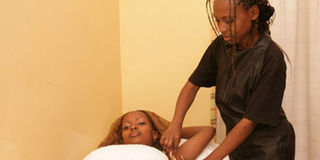Premium
Getting the best out of body waxing

PHOTO | FILE A woman gets her underarm and leg hair removed through waxing. Even though this option of hair removal is uncomfortable, many women prefer it because the results are long-lasting.
What you need to know:
- Women looking for smooth, silky skin are turning more and more to professional hair removal. And regardless of the body part, they are willing to endure the discomfort
Women love to flaunt the hair on their heads and will go to great lengths to get a full head of hair. But that is not so with hair on their other parts of the body.
Yes, I know it is hard to imagine that we do indeed have entire sections of our body that are not glossy, soft skin with the consistency of an egg-shell, but there it is.
Body hair removal is an industry unto itself from depilatory creams, waxing, threading and tweezing all the way to lasers. One of the most common is waxing treatments, which vary from full body wax, to arm, leg, bikini wax or under arm. Here is what you may not know about this treatment.
1. Waxing hurts. The application of slightly hot wax to the skin, a piece of fabric spread on it to allow it to dry as the wax attaches itself, which is then ripped off fast with your hair attached is not candies and cakes. Your skin will flinch as will you.
Occasionally, when you wax, your skin will tear, and may even bleed. Don’t be shocked if you see a few droplets of blood. It’s no reason to attack your aesthetician.
2. If it’s been a while in between wax jobs, don’t trim your hair with a pair of scissors. It blunts the edges of your hair which are critical for that death grip that makes yanking possible.
Waxing blunted edges is impossible and excruciating. So leave the job to your aesthetician.
3. Check that your aesthetician doesn’t double dip. She should not use the same waxing stick for two separate clients. Apparently, the laws of waxing allow for the same pot to be used more than once.
For hygienic purposes then, every woman must have her own stick. Salons and spas buy wax in bulk in jars and use until finished. They can’t afford separate pots for every client.
4. Some wax heaters come with in-built thermometers to ensure the temperature is just right. Ideally, wax should be slightly hotter than your body temperature, but not enough to burn.
The challenge is your aesthetician can’t exactly do the elbow dip test so they will use one of two ways – science, which is an inbuilt thermometer, or experience, where they know how low and slow the heat is.
This is precisely why you need a recommendation when it comes to who approaches you with a waxing stick.
PRICE RANGE
5. Cost does not necessary mean skill. Different salons and spas have varied rates depending on overheads, location, clientele they are trying to attract all the way to the working station an aesthetician uses.
As a client, you walk into an already existing price range. High cost is not a guarantee of great service and neither is lower costing an indicator that you will not get bang for your buck.
6. Waxing will not necessarily take every single hair off from your lady bits. The contours of your body make it challenging, and the aesthetician is aware that you are gritting your teeth all through the experience.
You both want it to over with as soon as possible. To prepare, exfoliate lightly a day before and, in fact, make it a habit to exfoliate your entire body with a granule scrub.
Whatever leaves you with soft skin leaves you with soft hair. Otherwise your follicles will feel shy and won’t release your hair easily.
7. Your skin care products matter. Always use sunscreen on waxed areas. They are doubly sensitive to the sun. Avoid using Retin A the day before you go waxing and the day you actually wax. Some purists have recommended a 10-day timeline on Retin A, but that is rather excessive.
Once you have waxed, use 1 per cent hydrocortisone cream for the first two or three days.
Aloe vera won’t soothe. That’s a myth. Instead, get a facial product with salicyclic acid as the active ingredient. Apply that twice a day. It prevents cysts, bumps and inflammation better than anything the hair removal industry has invented to date.
When hair starts growing back it doesn’t exactly push out prettily. It’s like a jostle to get out. Salicyclic acid minimises the impact of this on your skin.
8. You can get infections when you wax, but not the kind you think. The inflammation of your hair follicles is the most common.
POST-WAXING
Think individual cysts underneath the skin that might need lancing. Preempt those with salicyclic acid and exfoliating. The latter must only happen after the 4th day of waxing. The reason you’re so smooth post waxing is because it comes off with dry, loose skin.
9. There is a time for everything. And that includes a good wax job. Never wax the week leading up to your period, never, ever, under any circumstances wax when it is that time of the month, or, on the week of your ovulation.
Why? Your threshold for pain is much, much lower. Waxing is painful enough. Why go when your body is least prepared for it? The best time to wax is five to seven days after the last day of your period.
Avoid appointments when it is busy. Go on a Monday, afternoons, mornings when there is a lull in the salon or spa. If you anticipate a sexually active weekend, wax the nether regions on Wednesday.
It takes a couple of days for the sensitivity to subside. Avoid physical activity post-waxing and wear loose clothing. Ditch the jeans.
10. You may be conflicted about waxing. There will be entire armies that will insist your hair serves a purpose. That it would not be a part of your body otherwise and its role is protection and to define you as a woman as opposed to a pre-pubescent child.
If you chose to lose it you will be confronted by opinionated critics who wouldn’t even try it once and have to listen to them preach, describe waxing as faddish and disregard that it is, indeed, a personal choice. It will have to be a personal sign of your own autonomy. It is, after all, your pain.
11. Don’t be a big baby. Waxing is quick work. Your aesthetician doesn’t have time to hold your hand. They are already getting far more intimate with your body than most humans ever will.





